
Avalanches > Slab Avalanches
A snow slab is basically a cohesive layer of snow sitting on a weaker layer. The danger with slabs is that a large mass of snow can slide down a slope burying a skier. Slabs can be divided into hard and soft although the boundary is something of a continuum. Soft slabs are comprised of fresh snow, usually with less than 30% water. Over time soft slabs can transform into hard slabs as crystals bind together. Hard slabs can also be formed under the action of wind where the fine crystal structures are broken down under a sintering action. The classic wind slab that forms on lee (sheltered) slopes often close to ridgelines and cols. However backcountry travellers should avoid focussing on this one instance. Gilles Brunot, avalanche forecaster for Meteo France in Chamonix, says that the majority of avalanche accidents are not caused by wind slab but that most slab avalanches are due to weaknesses in the snow pack, whether they have been formed under the action of wind or not.
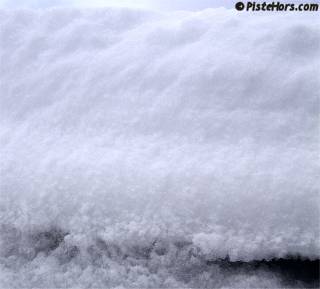
Snow slab sitting on a weak layer
Soft slab avalanches can form anywhere on a slope where there is sufficient snowfall and are undetectable from powder snow. They are usually small slides which break directly under a skier or snowboarder but are never the less deadly, especially where there is a flat runout, terrain trap, trees or cliffs.
Although slabby snow is relatively easy to spot, especially close to the top of couloirs or other terrain features hard slabs may also get buried by fresh snowfall making them very difficult to detect. As hard slabs grow stronger they become harder to trigger. There is a bridging effect. The pressure exerted by a skier forms a kind of bulb shape beneath his skis or board. Slabs over a meter thick are very hard for a skier to trigger directly. Group spacing when climbing and skiing can play an important role where strong slabs are present.
Slab avalanches are responsible for around 75% of fatalities and are triggered by the victim or a member of his group in 90% of cases. They are therefore the most important type of avalanche as far as backcountry safety is concerned and also avoidable by route planning and safe travel procedures. They are most common in the winter - January and February in France but can occur even in the mid-summer on high mountains such as Mont-Blanc.
Alain Duclos and François Louchet have described slab release as a four stage process. First of all a snow slab is separated from older snow by a weak layer. The slab itself may deform elastically under stress, such as the load from a skier but eventually fail in a brittle way if sufficient load is supplied. In their Model the snow slab is symbolized as a series of cohesive blocks linked by springs. It is held in place by cohesive resistance with the surrounding snow and shear resistance with the weak layer.
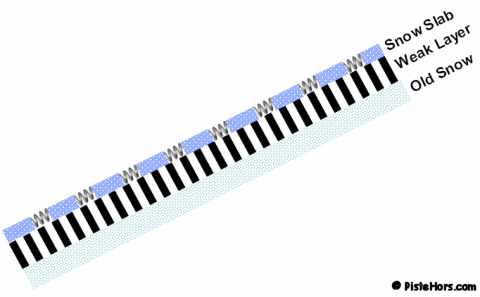
The weight of the skier or snowboarder is relatively insignificant (80kg) compared to the snow slab (1000's of tonnes). The weight of the skier is applied across a relatively small surface area (the ski or snowboard base). The pressure may locally damage the weak layer. The collapse of this layer reduces the shear resistance to almost zero.
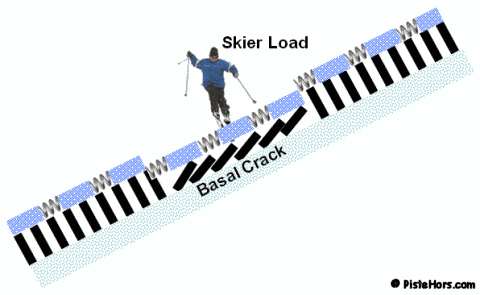
Snow slab collapse
Two things may now happen; the basal crack (that is, the crack between the snow slab and older snow, invisible on the surface) may propagate along the skiers path as he damages more of the weak layer (subcritical triggering) or the basal crack may propagate over a wide area under the weight of the snow (supercritical triggering). Effectively the weak layer collapses like a series of dominos in all directions driven by downward force of the snow slab.
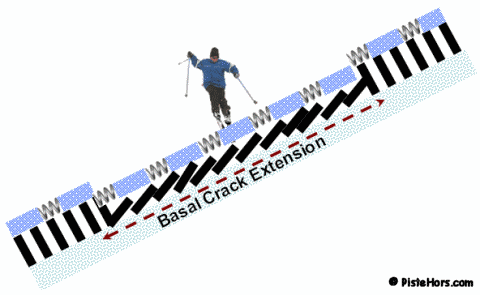
Basal crack propagation
As the basal crack propagates outwards the slab weight that was partially held by the shear resistance is transferred to the cohesive bonds with the surrounding snow. A crown crack will form at the top of the basal crack when the tensile stress reaches some critical value.
In the case where the basal crack propagates along the skiers path the slab may be released where the slab cohesion is low. The avalanche will release under the skier. However if the slab is stronger it may not actually be released and the skier may be unaware of the danger except for perhaps a loud whump as the weak layer collapsed.
In the case of a larger, stronger slab the basal crack may reach a critical threshold for expansion under the weight of the snow slab before the crown crack can open under the skier. The basal crack will expand with increasing velocity (up to 70km/h has been observed) with the crown crack opening over a wide area often at some distance from the skier.
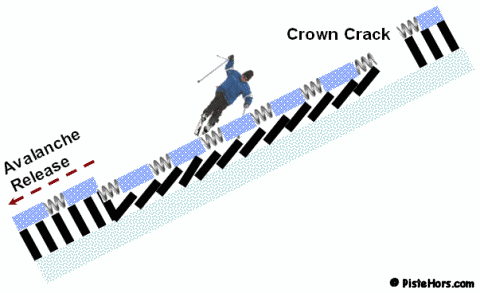
Slab release
Louchet has calculated that this type of triggering is favoured by large slabs on slopes around 35.3 degrees rather than 45 degrees that may be expected with using a purely mechanical model. The crown crack will spread rapidly until the slab separates from the upper snow, the bottom rim then normally fails as the whole weight of the slab is transferred to it.
In reality during and immediately after a storm cycle we observe many small soft slab avalanches which usually trigger directly under a skier. As the remaining slabs gain strength we observe larger but less frequent hard slab releases. Crown cracks often open at trees or rocks or old ski tracks. These features help crown crack formation as they are a weak point in the snow pack, however they mitigate against larger slab formation. Avalanches can also be triggered remotely, even where the traveller is on flat ground, either below or above the slopes at risk, as the basal crack can propagate onto surrounding slopes often resulting in several slides. It is not unheard of for skiers to be pulled off ridgelines as the basal crack propagates upwards onto flatter ground.
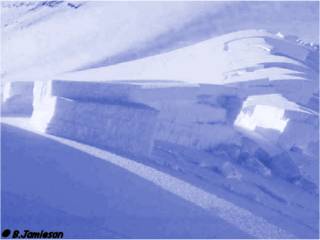
Here the basal crack has extended over the ridge
Of course a number of skiers may travel a slope without triggering a slide as the weak layer collapse doesnt reach a critical threshold. As more skiers traverse the slope the collapse layers may link up creating enough load from the unsupported slab to cause basal crack propagation. A reminder that tracks are no guarantee of safety. Advice might be to follow existing tracks, either when skiing or traversing a slope at risk in order to limit basal crack propagation. However for thicker slabs repeated traverses at the same point penetrate the snow pack deeply enough to cause the buried weak layer to collapse.
Snow cover on slopes is rarely consistent. The depth and stiffness can vary. This can cause problems for experienced mountaineers who may pay close attention to the snow in their immediate surroundings. A slope that seems reasonably safe may slide where the basal crack runs much further under strong or thicker snow cover. In other words triggering goes unexpectedly from sub to supercritical. The skier then finds himself in the middle of a large slide with the crown opening far above him. Such a slide is usually fatal. Duclos and Louchet warn against trying to predict whether sub or supercritical (favoured on large 35 degree slopes) will occur.
Insight into Slab-Avalanche Triggering. A combination of four phenomena in Series. François Louchet and Alain Duclos. The Avalanche Review. Vol 24 no 3, Febrary 2006
Possible deviations from Griffiths criterion in shallow slabs, and consequences on slab avalanche release - F. Louchet, J. Faillettaz, D. Daudon, N. Bédouin, E. Collet, J. Lhuissier, and A.-M. Portal
Fractures in weak snowpack layers in relation to slab avalanche release Alex François Guillaume van Herwijnen
<< | Avalanches | Loose Snow Avalanches >>